PRO-JECT THE CLASSIC Evo Review – Classic style
Pro-Ject’s Classic Evo turntable comes with a moving coil cartridge for wonderful vinyl sound finds Noel Keywood. Read our PRO-JECT THE CLASSIC Evo Review.
Contents
As its name suggests, Project’s The Classic Evo turntable is traditional or ‘classic’ belt drive design, [with arm. There is no onboard phono stage and no automation of any sort: with this one you lift the arm manually onto an LP then lift it off at end. The intention is to offer a relatively simple to use basic turntable of good underlying performance, free of fripperies. But it is for those who don’t mind getting involved, as a prodigiously large bag of bits that accompanies it testified. I had to roll my sleeves up!
The Classic Evo is fundamentally a two speed belt-drive design – 33rpm and 45 rpm – but you can, with a belt change, get it spinning at 78rpm. However, since the arm has a fixed headshell changing to a cartridge with 78rpm stylus makes this impractical and unlikely. A
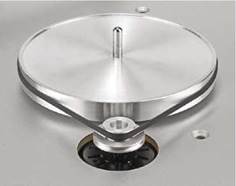
For 33rpm and 45rpm there is a flat, ground belt. For 78rpm a round section O ring belt must be fitted to the larger pulley.
moving-magnet (MM) cartridge with easily replaceable stylus is an option. Because old shellacs are a minority interest spinning 78s is a side issue I won’t get into here.
Instead The Classic Evo comes with an Ortofon Quintet Red moving coil (MC) cartridge purposed for normal microgroove LPs, tracking at a recommended 2.3gm and fitted with a non-removable elliptical stylus. This is a peculiar choice in that it demands an MC phono stage and negates the 78rpm option. Yet at the same time it does give MC sound that was, I found, wholly appropriate for the turntable – and also classic. The Quintet Red is a budget MC, by the way, priced around £ if bought separately.
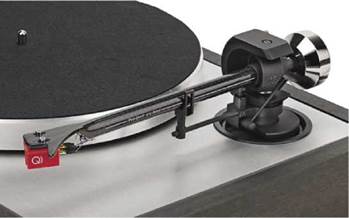
A one piece wrapped carbon fibre arm with flat finger lift. There is a damped cue platform for those who prefer it.
The Classic Evo is classic in using a hub with main bearing, belt driven at its periphery, as used by Thorens long ago on their simple but effective TDI60. Where Thorens suspended a pressed steel chassis on springs for isolation, Pro-Ject use a firmer suspension that simply isolates from acoustic vibration, so there are transit screws to be removed before set-up. And where Thorens used a synchronous a.c. motor Pro-Ject use an altogether more modern d.c. servo motor driven by an internal supply, fed from an external wall-wart I5V (0.8A), with lead 2m (6ft) long. That means speed change is electronic and at the push of a button, speed accuracy and stability determined by electronic means internally. The system worked slickly, small black push-buttons selecting speed or, with a long press, turning off.
On top of the steel hub sits a heavy steel platter with thin felt platter mat. The platter only needs to be removed if the separate 78rpm belt is fitted. The standard belt is a high precision flat-ground type, whilst the 78rpm belt is a simpler O-ring type.
Pro-Ject fit their own wrapped carbon fibre arm with integral headshell. The finger lift is flat and not to my liking because it’s difficult to get a finger underneath – too little clearance above the LP – and, being flat, easily slips out of a light grasp. But most people will use the damped lift/lower. It would be better if Project dispensed with their finger lift altogether, offering an optional bolton type with upward curve for easier and more assured use. These cost pennies and can be left off by those who’d prefer to use the cue platform.
Now to the bag of bits! And there are plenty of them. For a start, you get two belts, plus handling gloves and a duster, and signal cables (with earth). There’s a screw- on uncalibrated counterweight, bias weight on thread, alignment protractor, hook tool, three screw-on feet, three hex keys and simple stylus pressure gauge, but no bearing oil or stylus brush. The instruction manual didn’t list all the bits in our box (duster, alignment gauge) so contents may vary.
Before all else the three feet must be screwed on and they are height adjustable, as well as offering a degree of isolation. Well made and a nice touch, ignored by even Rega with their Planar I0. The hex keys are for setting arm height and cartridge azimuth. The balance gauge is needed because the counterweight is uncalibrated – unlike most turntables from the Far East. Don’t know what the hook tool is for: the manual makes no mention of it. Possibly to hook the belt?
A small technical note is that use of an external I5V supply means the unit is not mains earthed, making a hum loop impossible – so no hum from this source. It’s now a common and effective design approach.
The arm’s fixed headshell makes cartridge changing difficult. But this is a classic design aimed at those who are able and prepared to cope with such a fiddly process – so not an issue perhaps. Top quality arms from Rega and SME have similarly fixed head shells – if with better finger lifts – making Pro-Ject’s arm no different from other high-end types in this particular respect.
A solid acrylic dust cover is supplied, moving on simple friction hinges. Not as smooth and slick as those with spring counterbalanced hinges, but satisfactory
Once this melange of parts had been assembled and all adjustments
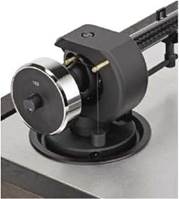
An uncalibrated rear counterweight and classic weight-on-thread bias system.
made The Classic Evo looked good
– neat and shiny. Dimensions of 462mm wide, I3Imm deep and 351mm high lid closed, and 432mm high, 390mm deep (I5in) lid open, make it a standard package size-wise but a deep shelf is needed. It will fit a I9in rack easily. Weight was a solid II.5kg, due substantially to the steel hub and platter – heavier than the light, cast aluminium platters favoured in budget Far East turntables.
Raising the issue of big platters
– and big main bearings to support them. A massive platter in an equally massive main bearing on a firm base resist vibration and historically have yielded best sound – think Garrard 40I here. Technics turntables also follow this constructional logic. The Classic Evo is similarly built.
SOUND QUALITY
I connected The Classic Evo to our Icon Audio PS3 Mk2 valve phono

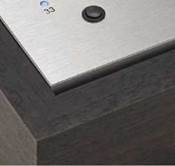
Speed selection is made by a small black push button. It selects Stop when held down.
stage, feeding an Icon Audio Stereo 30SE single-ended valve amplifier driving Martin Logan ESL-X hybrid electrostatic loudspeakers through Chord Company Signature Reference cables.
I start off vinyl play, at present, with a nicely simple but straightly balanced LP, Two Countries, One Heart – an all-analogue modern pressing that is right down the middle in terms of sound quality – neither warm nor bright, just neutral. And that is how it came across, although with Fanfare For the Common Man I heard an easy sound with no treble emphasis and little groove noise. However, kettle drum strikes were big and bold, with great insight into the drum’s timbral properties. Muscular but at the same time relaxing, in good vinyl fashion.
Turning over the LP to play inner grooves had Rosella Caporale’s soaring ending to Time To Say Goodbye hold steady and clear, with vivid power behind it. I was a little transfixed by this since on inner grooves sustained vocal crescendos can become unsteady. Not so here. However, at this point I was beginning to pick up some slight midband glare that made for a very explicit and forward delivery, full of insight and detail – impressive but not laid back.
With Hugh Masekela’s Uptownship from his Hope LP (180gm all-analogue) I enjoyed a fruity blare from his trumpet, hand drums with body to them and a solid bass guitar line. This track marked out The Classic Evo as able to support LP dynamics, delivering a powerful sound informed by insight.
Cut into outer grooves, Neil Young’s Tell Me Why is as good as it gets for close- miked acoustic guitar strings and here I heard a full bodied sound, guitar sounding rich detailed and resonant. There wasn’t the speed/laceration I know from better stylus tips (Shibata etc), the Quintet bringing a softer approach – in line with its frequency balance. I would have liked a little more speed and vivacity.
With Big Band Spectacular, a recent direct-cut of the Syd Lawrence Orchestra, the rolling drum intro to Sing Sing Sing had thunderous power and a strong grip on tempo. This is a masterful recording, one able to belittle CD – and that’s just what I heard with The Classic Evo. It brought out the sheer listenability of LP as well as its dynamic power. Some hardness of tone contributed to the sense of pace and control, so think speed and drama here, rather than mellowness.
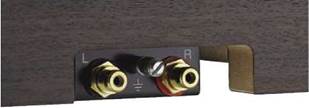
A pair of solid gold plated RCA phono sockets at rear, with earth terminal. There are no other outputs.
Yet at the same time our electrostatics put up a big sound stage that was both clear and deep, that sense of depth LP can provide being on full display.
CONCLUSION
Pro-ject’s The Classic Evo is a turntable for vinyl enthusiasts who know a thing or two about set up and are prepared to make the effort. Once up and running it gives glorious “classic” sound from Ortofon’s Quintet Red moving coil cartridge – but you will need a decent moving coil preamp to hear this. Then you get true vinyl sound in the higher echelons of what is possible, albeit old style with mild treble.
MEASURED PERFORMANCE
With a 3150Hz test tone (DIN 45-452 test disc) Pro-Ject’s The Classic Evo held speed both accurately and tightly, wandering from 3150Hz-3153Hz on our Wow&Flutter meter, making it essentially accurate in speed and with little variation around nominal. The turntable was run for 24hrs before this measurement.
As a result of low wander, speed

stability was very good for a belt drive. Wow measured just 0.1% (DIN) and Flutter of 0.06%. The total W&F value, DIN weighted, was 0.07%, our speed stability analysis showing the usual variation peak at 33rpm (0.55Hz) at low-ish level. There is little in the way of flutter peaks at right.
Although not an aluminium tube, the arm is still stiff and rings quite obviously under analysis with a Bruel&Kjaer accelerometer on the head shell, tuning-fork type resonance occurring at 220Hz. However, this apart the arm is fairly well controlled and damped, especially at high frequencies (above 1kHz) where the integral carbon fibre headshell works very well.
Frequency response of Ortofon’s Quintet Red fell steadily toward high frequencies, measuring -3dB down at 10kHz. On inner grooves this rose to -5dB down – substantial and subjectively obvious as warmth, or dullness. Tracking was good at 2.3gm recommended VTF.
The Classic measured well but wasn’t without small blemishes in arm and cartridge.
Speed error 0%
Wow 0.1%
Flutter 0.06%
Wow & Flutter (DIN wtd.) 0.07%
PRO-JECT THE CLASSIC TURNTABLE
OUTSTANDING – amongst the best.
VERDICT
When you purchase through links on our site, I may earn an affiliate commission. Here’s how it works.
Henley Audio
+44 (0)1235 511166 www.henleyaudio.co.uk

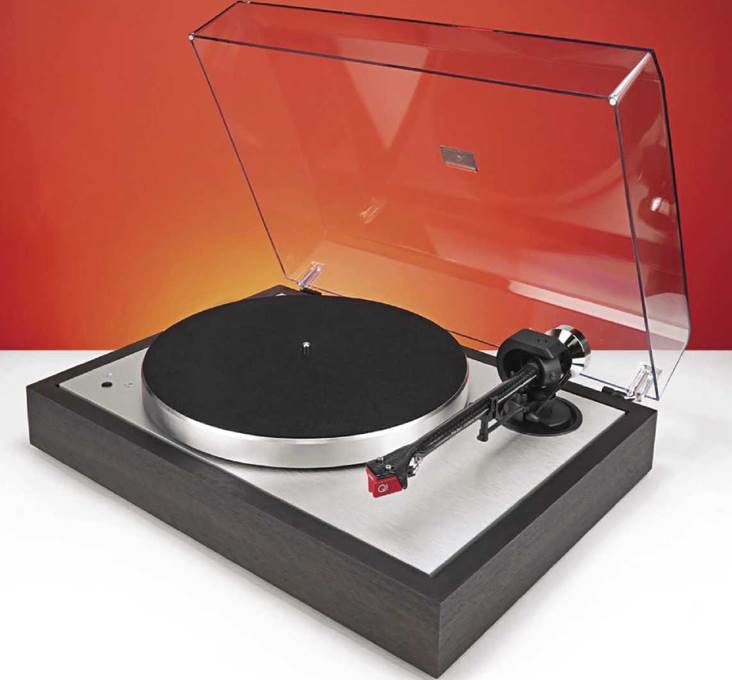




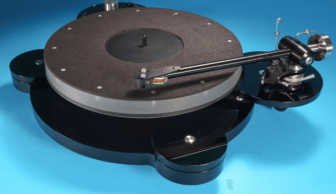
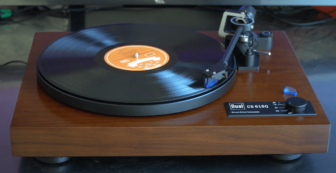

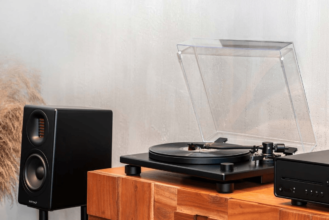
mine won’t spin – at 45rpm any thoughts?